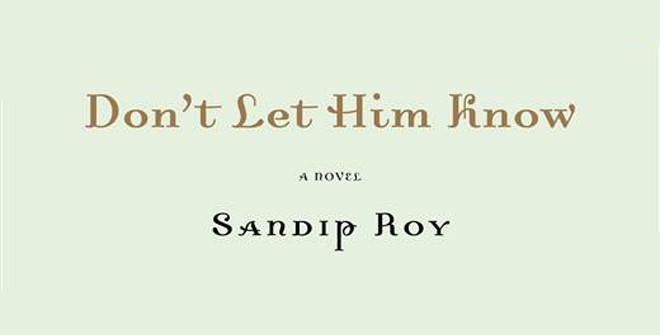
Twelve fairly decent stories with occasional moments of brilliance

The first book of fiction by Sandip Roy, Don’t Let Him Know, is a novel in stories or at least that is what the book claims. Joyce’s Dubliners is treated as a collection comprising fifteen interconnected short stories, while Jean Toomer’s Cane is treated as a novel. Junot Diaz’s This Is How You Lose Her is both while Yunior the central character has already appeared in his two previous books. What fits the bill? A book’s claim notwithstanding, how does a reader decide? The tricky part about "a novel in stories" is that each story needs to serve both needs: a) to stand alone as a story and b) to work as a chapter. A chapter is not a story, though in good hands the feat can be accomplished occasionally.
Often, however, there is a price the author pays. And I think that is the price Roy pays despite having written twelve fairly decent stories with occasional moments of brilliance. One such moment occurs in the very first story, A Happy Meal, when Amit casually confronts his mother with a letter he thinks was written to her by Sumit whom she might have loved once. She is stunned and speechless. Amit comes to her rescue insisting it’s no big deal.
The first page of the letter is missing, so Amit doesn’t learn that the letter was in fact written to his father, nor she cares to tell him that. That’s an interesting choice and a wasted golden opportunity. That night the anger she feels deals with feminist issues: "Amit was right. She had done everything everyone expected her to do… no one had ever asked her if she wanted to do anything at all. All she had ever got to decide was what fish to serve… after Avinash’s death, not even that. Rui, paarshey, ilish…"
The story doesn’t simply descend to the terrain of food orientalism, it metamorphoses into junk food exotica. Even in her sleep she has dreams, not about Sumit and Avinash, but fish, pizza and burgers. "I am going to McDonald’s," said Romola to the television. "And no one can stop me." Now that’s what I call determination.
As the story takes a McDonald’s turn from a high point of a son mistakenly confronting his mother, the reader feels cheated belatedly, in the next story, Ring of Spices, when the full letter is shared with the reader. Then, again, she cannot muster the courage to confront him or at least sort out the confusion. She keeps it all in and find solace in neatly arranging spices and tries to remember the English for methi. Even though Avinash asks her, "Are you all right?" the next page till the story ends is larded with turmeric, coriander, cumin.
This trope -- finding emotional shelter in food and cooking when ones sexual life remains unfulfilled and one falls a victim to unrequited love -- could work by daring to go deeper into a character’s life. Deceptively simple prose and impressionistic flourishes might not help.
Roy has written his stories with caution both in terms of prose and how deep he might wander into uncharted territory. This leaves the reader unconvinced as to the motivations of the character. Take, for example, Romola’s restraint with regards to confronting her husband and withholding information from her son and comparing those with her actions in the following stories, Requiem For a Star and Scene of the Crime. The first is about her short-lived love affair with an actor who went on to become the Dilip Kumar of Bengali cinema. She went on dates with him, but for sociological reasons their marriage was not approved. On his death, while Avinash is still alive, she dares to part the sea of fans, even loses her shoes. Arguing and brow beating the gatekeeper, she is no demure thing.
In the latter story, she slips out at night, while her son and family sleep, to track down the flat she had first come to as a new bride.
When she takes a wrong turn, and is lost, she finds herself in a gay bar only to befriend a South Asian drag queen named Lady Bang la Dish. There Romola lets loose her bottled up Bollywood emotions starting with mera naam chin chin choo. It doesn’t stop there and by the time the story winds up Romola had had a quite a few shots of hard stuff too.
Romola’s highs and lows are too neatly dictated by the narrator with very little agency to the character herself.
For my personal taste the better imagined stories are The Discipline of Haircuts and White Christmas. The first one deals with Avinash’s boyhood as he experiences the first stirrings of attraction towards other males, especially the barber Sultan, but class differences, though Roy doesn’t explore the issue, make sure never the twain shall meet. The moments of brilliance to which I alluded in the beginning, also occur in the second story and at the right note.
Amit, who finds himself alone during Christmas break, wanders into a bar and is smitten by an African American woman with blue eyes. Ending up in her bed afterward, the point is driven home, as the young woman takes off her lenses before their second round of desserts, about South Asian men’s internalised racism and mental colonisation. Roy gives a hint of awareness to social and racial issues, but his restraint with writing does not allow him to disturb the status quo. It is in this sense I feel that the book fails to rise above its potential. It is written, and perhaps edited and packaged, too carefully. Though all the stories hold your attention, the aftertaste is that of a wasted opportunity.